by Lisa Cooke | Apr 28, 2017 | 01 What's New, German, Records & databases
German marriages, Indexed obituaries for the U.S., Canada, the U.K., Ireland, Australia, and New Zealand, The ultimate photo map of the 1906 San Francisco earthquake, and UN War Crimes Commission reports from World War II are all in our new and updated genealogy records today!
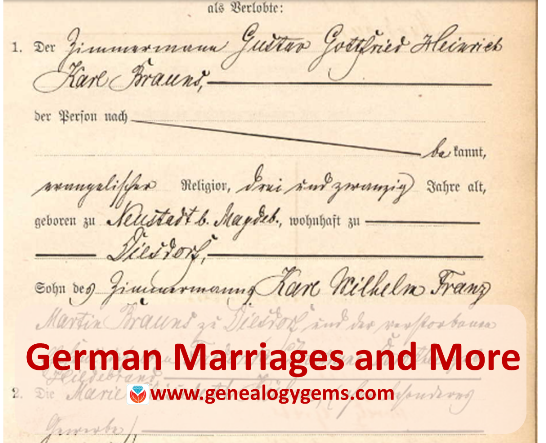
Germany Marriages: Magdeburg
Ancestry.com has published a new collection of over 600,000 marriages recorded in Magdeburg, a city about 80 miles west of Berlin. According to the collection description, “Beginning on October 1, 1874, local registry offices were made responsible for creating birth, marriage, and death records in the former Prussian provinces. The collected records are arranged chronologically and usually in bound yearbook form which are collectively referred to as ‘civil registers.’ For most of the communities included in the collection, corresponding alphabetical directories of names were also created.” The records date from 1874-1923.
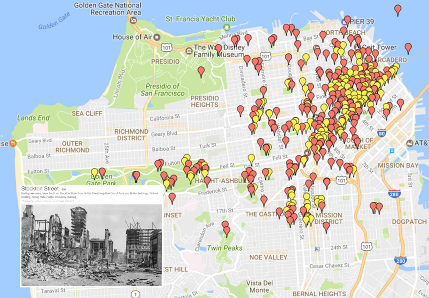 1906 San Francisco Earthquake: The Ultimate Map
1906 San Francisco Earthquake: The Ultimate Map
A new interactive map plots the likely locations of thousands of photos taken of the “smoke, fire, ruins and refugees” after the 1906 San Francisco earthquake. The map at OpenSFHistory references stunning images of bewildered survivors amidst their devastated neighborhood, reminders of the brutal and total losses many incurred in a few seconds.
- Got a disaster story in your family history? Read these tips on researching it.
- Was London the scene of your family’s disaster–specifically, the London Blitz? Click here to learn about an interactive map of the bombing of London during World War II.
Indexed Obituaries at Ancestry.com
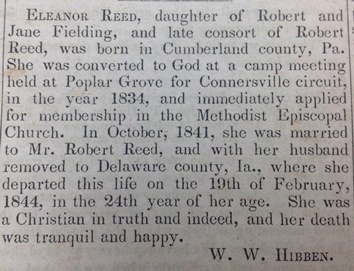
Obituaries such as this one from the Western Christian Advocate (Cincinnati, June 28, 1844) often reveal unique personal and family information.
Ancestry.com recently updated several enormous national obituary indexes:
- U.S., Obituary Collection, 1930-2016 (and a related collection, U.S., Cemetery and Funeral Home Collection, 1847-2017)
- Canada, Obituary Collection, 1898-2015
- UK and Ireland, Obituary Index, 2004-2017
- Australia and New Zealand, Obituary Index, 2004-2015
Thousands of obituaries or death notices are searchable in digitized newspaper collections, but indexes dramatically improve the odds of discovering them. Then the trick becomes tracking down the original paper to see it for yourself. Learn more about finding obituaries (and everything else in newspapers) in How to Find Your Family History in Newspapers by Lisa Louise Cooke.
South Africa Court Records
Over 200,00 records appear in Ancestry.com’s new database, South Africa, Miscellaneous Court Records Index, 1652-2004, 2008-2011. Spanning more than 350 years, the collection indexes records from the Courts of Justice (1652-1956), Cape Town Criminal Records (1854-1855), Official Name Changes (2008-2011), South African Law Reports (1828-2004), and the 1859 Weenan, Natal Jury List.
“The details provided for each person typically include name, record date, record place, collection, and source,” states the collection description. “Depending on the collection, additional details such as occupation, place of residence, names of relatives, or information on a court case or crime may be available as well.”
UN War Crimes Commissions Archive Opened
The Guardian recently reported that the UN War Crimes Commission archives is being opened in London and its catalog is now searchable online. “War crimes files revealing early evidence of Holocaust death camps…are among tens of thousands of files to be made public for the first time this week,” says the story. “The archive, along with the UNWCC, was closed in the late 1940s as West Germany was transformed into a pivotal ally at the start of the cold war and use of the records was effectively suppressed.” The archive contains thousands of pages of evidence collected (much of it in secret) even as the war raged, and includes detailed descriptions of Nazi extermination camps, massacres in Czechoslovakia, and early war crimes tribunals.
Newspapers in the News
North Carolina
Digitized issues of The Franklin Times (weekly, searchable 1909-1924) are now searchable at Digital NC. The paper served Lewisburg, the seat of Franklin County, North Carolina. The paper has a fairly local focus, according to a blog post announcing the collection. “For example, one weekly column, ‘The Moving People,’ tracks ‘those who have visited Louisburg the past week’ and ‘those who have gone elsewhere for business or pleasure.’ The column lists individuals who returned from trips and those who visited from afar….Local meetings, contests, municipal issues, social events, and more are recounted each week.”
Washington
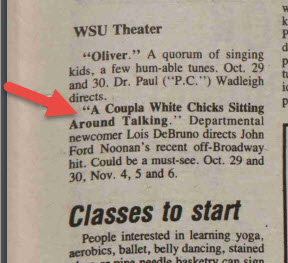 Lisa Louise Cooke just found a little piece of her own history in Washington State University’s student newspaper, now fully searchable online for free. It’s a short snippet that refers to a two-woman play Lisa was in!
Lisa Louise Cooke just found a little piece of her own history in Washington State University’s student newspaper, now fully searchable online for free. It’s a short snippet that refers to a two-woman play Lisa was in!
According to a Facebook announcement, a new digital archive includes 13,200+ issues of the The Daily Evergreen (1895-2016) and 660 pages of other newspapers, including an early official student paper, the College Record (1892-1893).
Find your own family history in newspapers of all kinds, from local dailies to labor presses or church regionals, or even student papers such as the one Lisa used above. “Read all about it!” in Lisa’s book, How to Find Your Family History in Newspapers.

Available at http://genealogygems.com
by Lisa Cooke | May 31, 2015 | 01 What's New, Digital Archives, FamilySearch, images, Libraries

A milestone 200,000 digital family history books are now online at the multi-library Family History Books collection at FamilySearch.org. The growing collection, which began in 2007, includes “family histories, county and local histories, genealogy magazines and how-to books, gazetteers, and medieval histories and pedigrees,” according to the landing page.
Last time I looked for books here, I found one on my Homer ancestors. This time around, I found another gem: a book of children’s stories written about these ancestors! Digitally-archived volumes like county and local histories, published family histories and others are so valuable because they are immediately accessible and because they are keyword-searchable. Try these keyword search strategies:
- Look for only a surname (in case the first name is written different ways or a different relative is mentioned).
- Search for the name of a neighborhood, street, church, school, business, type of work or other keywords that pertain to your family.
- Use the Advanced Search feature to focus your search for a keyword in a title, type of publication (periodical, etc).
Once you’re reading a book, you can click on the info icon (a circle with an “i” in it on the upper right) to see more information about the book, including source citation and copyright information.
While the number of volumes online skyrockets, the online Viewer for reading them is only gradually improving. Here’s a TIP from FamilySearch staffer Dennis Meldrum: “Safari does not work well with the Viewer.” Neither do mobile devices like the iPhone or iPad. “The Viewer works best with IE or Firefox. It also works with Chrome, but the Adobe Tools do not work. We are aware of the limitations of the Viewer and are working to replace it by the end of the year.”
 Want to keep track of which genealogy books are on your shelf and which you’ve found online? Create an Evernote genealogy library! Click here to learn how to do that with books on your shelf, and then add additional titles with the links in Evernote. Sharpen your Evernote skills for genealogy by becoming a Genealogy Gems Premium member. This gives you a full year’s access to our Ultimate Evernote for Genealogy Education, with five (so far) full-length video classes for beginner to expert and five mini-sessions, too.
Want to keep track of which genealogy books are on your shelf and which you’ve found online? Create an Evernote genealogy library! Click here to learn how to do that with books on your shelf, and then add additional titles with the links in Evernote. Sharpen your Evernote skills for genealogy by becoming a Genealogy Gems Premium member. This gives you a full year’s access to our Ultimate Evernote for Genealogy Education, with five (so far) full-length video classes for beginner to expert and five mini-sessions, too.
by Lisa Cooke | Oct 14, 2013 | 01 What's New, Evernote
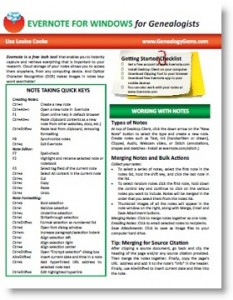 Evernote is certainly the fastest-growing (and FREE) note-taking technology out there, so it’s no wonder that it is incredibly popular with genealogists. But there’s a lot packed into it and I’ve noticed that many genealogists aren’t taking full advantage. Here’s are two of my favorite tips that I use all the time from my brand new Evernote for Windows for Genealogists cheat sheet:
Evernote is certainly the fastest-growing (and FREE) note-taking technology out there, so it’s no wonder that it is incredibly popular with genealogists. But there’s a lot packed into it and I’ve noticed that many genealogists aren’t taking full advantage. Here’s are two of my favorite tips that I use all the time from my brand new Evernote for Windows for Genealogists cheat sheet:
1) Create a New Note: When you’re working on your computer and you want to make a quick note of something in Evernote, you can get there with lightening speed by pressing these quick keys simultaneously: Ctrl+Alt+n.
2) Instant Note Search: What if you are knee deep in your research and you have a note that you need to quickly reference? Simply press Win+Shift+f from anywhere on your computer and Evernote will instantly open with your cursor in the search box ready to type a keyword and search!
Try these Evernote tips now! And then get LOADs more helpful tips in this 4 page laminated Quick Reference Guide, like:
by Lisa Cooke | Apr 3, 2012 | Census, Research Skills
It’s not every day that a new record group becomes available that will help you learn more about your family history. But yesterday, April 2, 2012 was one of those special days! Who will you be looking for? Do you plan on volunteering to help with indexing?
National Archives Releases 1940 Census
Washington, D.C. . . Ever wondered where your family lived before WWII; whether they owned their home; if they ever attended high school or college; if they were born in the United States, and if not, where? Unlocking family mysteries and filling in the blanks about family lore became much easier today with the release of the 1940 census by the National Archives and Records Administration. By law the information on individuals in the decennial censuses, which is mandated by the U.S. Constitution, is locked away for 72 years.

In a 9 A.M. ceremony in the William G. McGowan Theater, Archivist of the United States David S. Ferriero declared the 1940 census officially open. This is the 16th decennial census, marking the 150th anniversary of the census. Performing the first search, Mr. Ferriero said, “It is very exciting for families across America to have access to this wealth of material about the 1930s. Many of us will be discovering relatives and older family members that we didn’t know we had, picking up threads of information that we thought were lost, and opening a window into the past that until now has been obscured We now have access to a street-level view of a country in the grips of a depression and on the brink of global war.”
Dr. Robert Groves, Director of the U.S. Census Bureau added: “Releasing census records is an odd event for us; we spend all our lives keeping the data we collect confidential. However, once every 10 years, we work with the National Archives and Records Administration to release 72-year old census records that illuminate our past. We know how valuable these records are to genealogists and think of their release as another way to serve the American public.”
For the first time, the National Archives is releasing an official decennial census online. The 3.9 million images constitute the largest collection of digital information ever released by the National Archives. The free official website http://1940census.archives.gov/, hosted by Archives.com, includes a database of Americans living within the existing 48 states and 6 territories on April 2, 1940.
“There is a great synergy between the National Archives and Archives.com stemming from our passion to bring history online,” said John Spottiswood, Vice President, Business Development, Archives.com. He continued, “It has been a tremendous opportunity to work with the National Archives to bring the 1940 census to millions of people, the most anticipated record collection in a decade. In a short period, we’ve built a robust website that allows people to browse, share, print, and download census images. We encourage all to visit 1940census.archives.gov to get started on their family history!”
The census database released today includes an index searchable at the enumeration district level. An enumeration district is an area that a census taker could cover in two weeks in an urban area and one month in a rural area.
To make the search for information easier, the National Archives has joined a consortium of groups to create a name-based index. Leading this effort, FamilySearch is recruiting as many as 300,000 volunteers to enter names into a central database.
Questions asked in the 1940 census, which reflect the dislocation of the Great Depression of the 1930s, will yield important information not only for family historians and genealogists, but also for demographers and social and economic historians. We learn not only if a family owned or rented their home, but the value of their home or their monthly rent. We can find lists of persons living in the home at the time of the census, their names, ages and relationship to the head of household. For the first time the census asked where a family was living five years earlier: on April 1, 1935. This information might offer clues to migration patterns caused by the Dust Bowl and the Great Depression. For the first time in the census, a question relating to wages and salary was asked. Persons 14 years old and over were asked questions regarding their employment status: Were they working for pay or profit in private or nonemergency government work during the week of March 24–March 30, 1940? Were they seeking work? How many hours did they work during the last week of March? How many weeks did they work in 1939? What was their occupation and in what industry?
by Lisa Cooke | Jul 2, 2019 | 01 What's New, Records & databases |
Genealogical records come in all shapes and sizes and this week’s records round up even includes round records! Keep reading because you never know what you’ll find.
Photographs at Indiana Album
I love this website simply for the tag line Historic Photographs from the attic to the Web! We all have a bit of other families’ genealogy in our attics, closets and scrapbooks, and Indiana Album is a nonprofit organization that want to make it accessible. They encourage Hoosiers (and of course descendants of Hoosiers) to loan them their photos and documents. The group then digitizes, catalogs and shares them in a database on their website. Head here to search for the names, places and other keywords relating to your family. I’m finding gems like the one below.

Internet Archive’s Great 78 Project
Here’s a free online collection that is adding tons of new melodic content!
I’m amazed how often I run across music references in my genealogical research, particularly when reviewing the diaries, letters and other records of my late 19th century and early 20th century relatives.
When I was in my twenties I wrote my Grandfather often and asked him questions like “Do you remember any favorite songs from when you were a young man?” His answer included:
As you can see from the linked titles above (click them to listen for yourself), I found every single one of them at the Internet Archive’s Great 78 Project. This is a phenomenal free online collection of digitized recordings made accessible to everyone.
The good news is that the project, which currently boasts over 200,000 recordings, just received funding to preserve another 250,000 sides of 78 rpm records. That means they need records. So, check your basement, closets and attic and consider donating your 78s to the Internet Archive’s Great 78 Project for digitization and physical preservation. You can donate your 78rpm Records to the Internet Archive’s Great 78 Project here.

No Wonder (That I Love You) Gene Austin, 1925
UK & Iceland Records at Findmypast
There are over 6.4 million new records and newspaper articles available to search and explore this Findmypast Friday including over 264,000 new and exclusive parish records that have been digitised and made available online for the first time in association with the Lancashire Archives.
Lancashire Baptisms
Over 31,000 additional records are now available to search amongst out collection of Lancashire Baptisms. The new additions cover the parishes of:
- Edge Hill, St Nathaniel -1869 to 1918
- Liverpool, St John – 1785 to 1898
- Liverpool, St Silas, Pembroke Place – 1841 to 1918
- Liverpool, St Stephen the Martyr – 1851 to 1918
- Newburgh, Christ Church – 1860 to 1917
- Seaforth, St Thomas – 1839 to 1918
- Stoneycroft, St Paul – 1916 to 1918
- Toxteth Park, St Bede – 1882 to 1918
These records include both transcripts and images of the original documents. Each result will reveal when and where your ancestor’s baptism took place, the names of their parent’s and father’s occupation.
Lancashire Marriages & Banns
A further 179,000 records have also been added to our collection of Lancashire Banns & Marriages. These new marriage registers add coverage for a selection of new Liverpool parishes, including:
- Edge Hill, St Nathaniel – 1871 to 1943
- Everton, Emmanuel – 1835 to 1943
- Liverpool, St John – 1785 to 1898
- Liverpool, St Stephenn the Martyr – 1852 to 1943
- Seaforth, St Thomas – 1870 to 1943
- Stoneycroft, St Paul – 1916 to 1943
- Toxteth Park, St Bede – 1887 to 1943
Learn when, where and to whom your ancestor was married, as well as the happy couple’s ages, occupations, marital status, residences, parent’s names and father’s occupation.
Lancashire Burials
Over 54,000 new records from the central Liverpool Parish of St John. These new records span the years 1767 to 1883 and will allow you to discover when your Liverpool ancestors were laid to rest.
The transcripts and images within this collection will enable you to discover when your ancestor died, their occupation, the date and location of their burial, as well as their age at death.
United States Obituary Notices
A whopping 5.7 million new records are now available to search within our collection of United States Obituary Notices.
These records, obtained from the tributes.com and currentobituary.com websites will enable you to discover your ancestor’s name, birth and death years as well as the original obituary text. Additional information such as images and details about the records can be found on the source’s website.
Scotland, Darien Scheme Investors 1696
Explore the records of investors in The Company of Scotland Trading to Africa and the Indies, also called the Scottish Darien Company. It was funded by investments from people across Scotland. These transcripts will provide you with information on those who invested money and their representatives.
The Darien scheme was an unsuccessful attempt by the Kingdom of Scotland to establish a colony called “Caledonia” in Panama in the late 1690s. Opposed by commercial interests from England, the company of Scotland raised subscriptions for the scheme in Amsterdam, Hamburg, and London. English investors soon raised their share but withdrew their money after King William and the English Parliament turned against the venture. However, by August 1696 the Scottish investors raised £400,000 themselves.
As the scheme was backed by approximately 20% of all the money circulating in the country at the time, its failure left the entire Lowlands in substantial financial ruin and was an important factor in weakening Scottish resistance to the Act of Union. In July 1699, the colony was abandoned due to inadequate provisions, the unfamiliar hot and humid climate had caused fever to spread, and many settlers died. Of the 1,200 settlers, only 300 survived.
International Records Update – Iceland
To mark Icelandic National Day this week, we have made over 287,000 baptism and marriage records from the land of fire and ice available to search on Findmypast.
These two new indexes span the years 1730 to 1920 and will generate hints against your Findmypast Family tree.
British & Irish Newspaper Update
A bumper crop of new and updated titles have been added to the collection this week, with 163,404 new pages added. We have seven brand new titles added this week, covering both England and Scotland. We have three new London publications joining us – the Harrow Midweek, the Middlesex Gazette and the Middlesex Independent – as well as one Scottish title (the Northern Ensign & Weekly Gazette) and one new Essex title (the Essex Guardian). We are also delighted to welcome two specialist sporting titles – namely, the Volunteer Record & Shooting News, which ‘warmly supports the interests of the shooting man,’ and the Fishing Gazette, a publication which covers all types of fishing across the world.
Further to these new arrivals, we have also updated sixteen of our existing titles. Updates this week cover the length and the breadth of the United Kingdom and Ireland, with updates incorporating publications from Aberdeen to Jersey, from Kingston to County Down, from Bristol to Kensington, from Crawley to Strabane.
Navy Officer Letters at Fold3
Fold3 just announced “We have added a new collection of naval records to our archives! The Navy Officers’ Letters 1802-1884 is a collection of letters to the Secretary of the Navy from officers assigned to naval ships, stations, and Navy bureaus.
The letters contain routine personnel matters such as duty assignments, leave or furloughs, desertions, resignations, court-martials, and other administrative issues. The collection is organized by year and then alphabetically by sender. The letters offer a glimpse into military history and provide valuable genealogical records for ancestors that served in the Navy.”
British Newspaper Archive
This week the British Newspaper Archive added 137,896 new pages spanning 128 years from 1871 to 1999 to eighteen of their existing collections. These include extensive updates to the Walsall Observer, and South Staffordshire Chronicle, which cover the years 1873 to 1969 and includes nearly 35,000 pages.
Also updated: Six of their London titles, including the Acton Gazette, as well as three Scottish titles, with pages added to the Hamilton Advertiser, the Dumfries and Galloway Standard and the Aberdeen Press and Journal. We have added pages to publications covering Newcastle and Middlesbrough, as well as new pages to The People.
A subscription is required. Clicking on the titles above allows you to see examples and review the scope of the collection.
Full Disclosure: We appreciate when you use our links because if and when you subscribe we are compensated, which helps support this free blog and the free Genealogy Gems Podcast.

 1906 San Francisco Earthquake: The Ultimate Map
1906 San Francisco Earthquake: The Ultimate Map
 Lisa Louise Cooke just found a little piece of her own history in Washington State University’s student newspaper, now fully searchable online for free. It’s a short snippet that refers to a two-woman play Lisa was in!
Lisa Louise Cooke just found a little piece of her own history in Washington State University’s student newspaper, now fully searchable online for free. It’s a short snippet that refers to a two-woman play Lisa was in!






